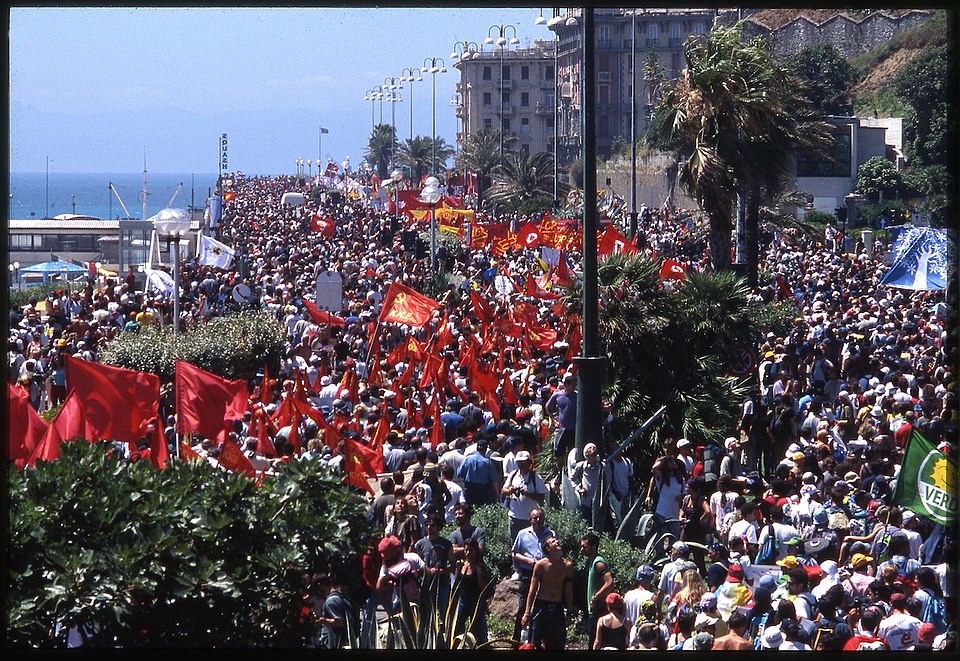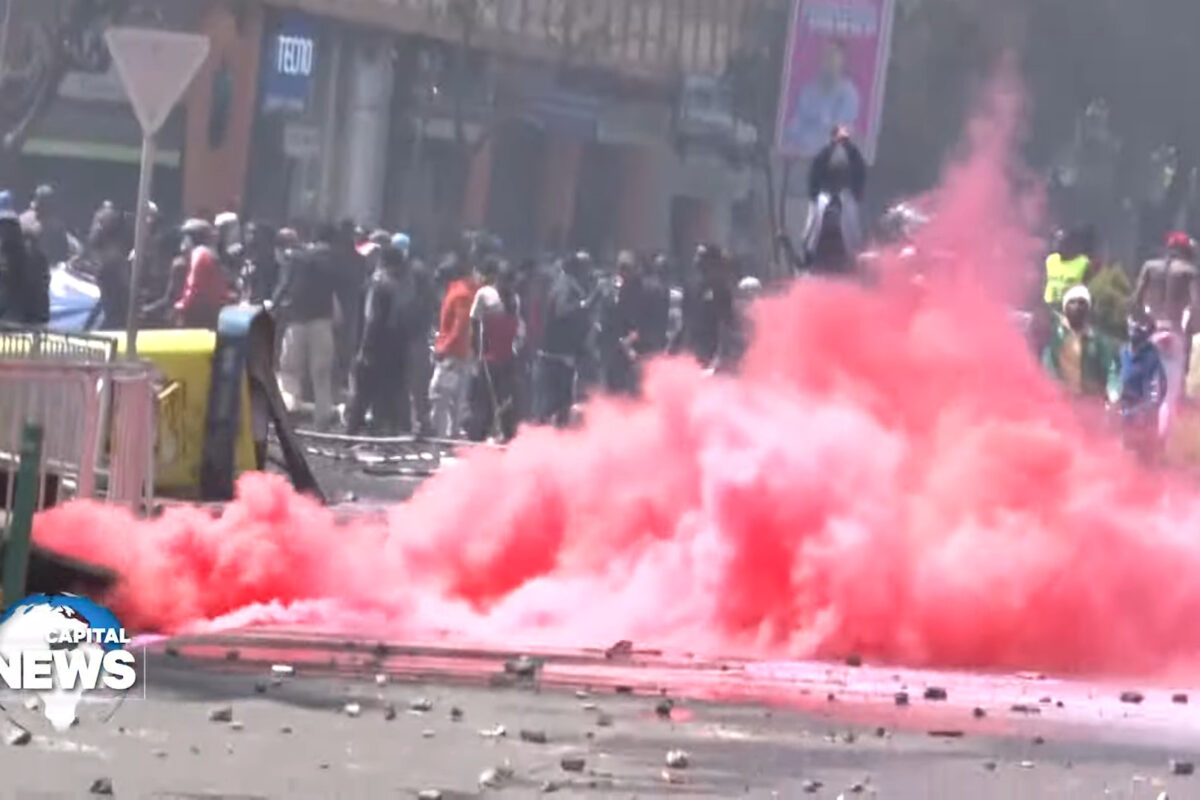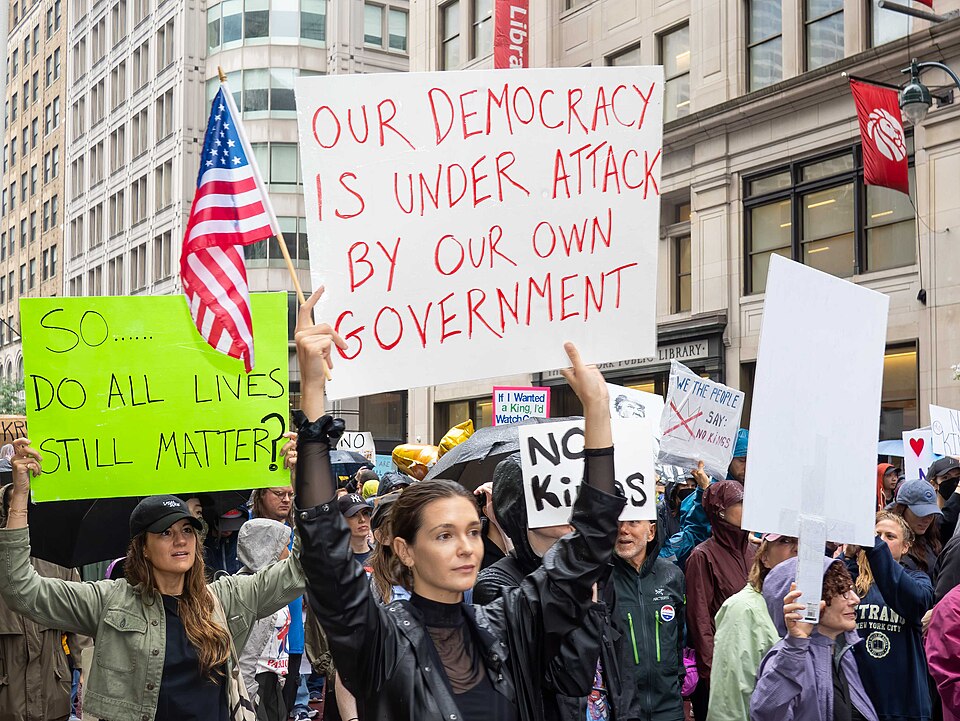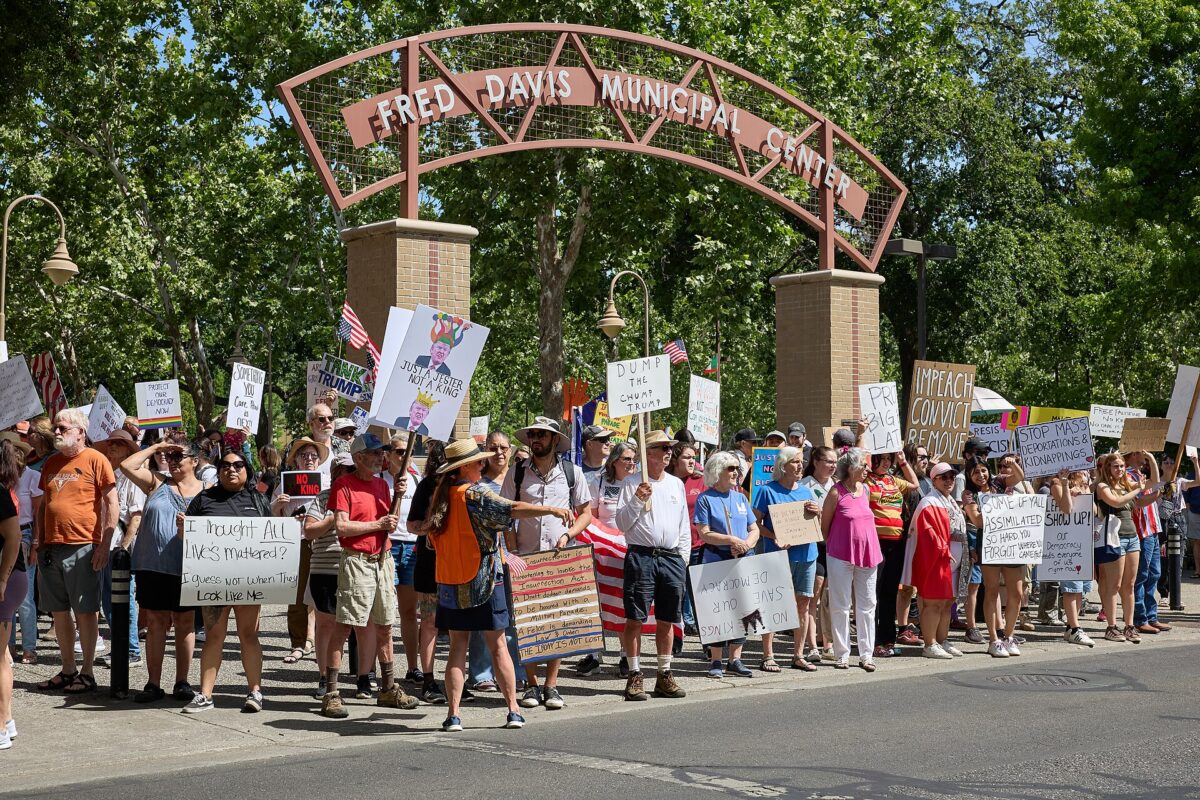Prelude: The Battle of Seattle
30 November 1999 was a historic day. Between 60,000 and 100,000 demonstrators shut down the World Trade Organisation (WTO) meeting in Seattle. The demonstration was not huge – certainly not compared to what followed. But Seattle was able to inspire an international movement and bring together different groups which had previously been divided.
As one protestor explained
“You’ve got people here from all over. You’ve got labor, you’ve got environmentalists, you’ve got teachers, you’ve got children, you’ve got coalitions between people of color and, you know, mainstream white Americans. You’ve got middle-class, you’ve got working poor, you’ve got poor. You’ve got everybody out here, because this hurts people. This is bad for people. It’s bad for our jobs here. It’s bad for the people over there. ”
This unity was reflected in the slogan “Teamsters and Turtles together at last”. The Teamsters were trade unionists, who had a large block on the protest. Turtles were ecological activists. Finally, a protest had managed to unite different groups which all suffered under the capitalist system. A new term became popular which had previously belonged exclusively to the radical left – that of “anti-capitalism”.
Seattle was important because of what it followed. Throughout the 1980s, the largest Western powers had been ruled by authoritarian right wing governments – Reagan-Bush (1981-93) in the US, Thatcher-Major (1979-97) in Britain, and Kohl (1982-98) in Germany. Strange as it may seem now, the elections of Bill Clinton in 1993, Tony Blair in 1997 and Gerhard Schröder in 1998 were accompanied by wild hopes of a new socially liberal future. But these hopes were soon dashed.
In April 1998, Schröder and Blair released a paper announcing the “Third Way”, a programme of neoliberalism made palatable by some moderate reforms. After 20 years of aggressive Monetarism, and continual defeats of the Left, Clinton, Schröder and Blair were seen by many as the best that we could hope for. In this sense, the outpouring of anger on the streets of Seattle – and later Genoa – was a significant break from the old consensus politics.
Dress rehearsals in Prague and Gothenburg
I want to argue that Genoa marks the moment when anti-capitalist politics came to Europe. But it was not the first attempt. In the aftermath of Seattle, many people in Europe were looking for something of their own. Two mobilisations helped feed these aspirations.
In September 2000, the International Monetary Fun (IMF) met in Prague. Despite massive police violence, demonstrations caused the summit to end early. The police estimated 5,000 demonstrators, although the figure given in Wikipedia is now 12,000. This was obviously no mass protest, but it gave a vision of what could be possible.
In June 2001, the EU met in Gothenburg, Sweden at a summit attended by US president George W. Bush. This time between 25,000 and 50,000 demonstrators turned up. Tony Blair reacted by saying that it was “an outrage that peaceful demonstrations had turned into ‘thuggery’”. A momentum was clearly growing.
As the number of protestors increased, so did the scale of police violence. Three protestors were shot, one of whom was critically wounded. In the end surgeons saved his life, but for those of us watching on the sidelines there was a feeling both that a momentous movement was forming, and that the reaction of the state was becoming increasingly lethal.
The road to Genoa
This was the prelude to the G8 summit in Genoa in July 2001. I was living in Stuttgart at the time, from which there was no organised transport that I knew of. Fortunately, in the week before the summit I was in Britain visiting family. I booked a place on the 500-seat train organised by the new anti-capitalist group Globalise Resistance.
It was touch-and-go whether this train would get to travel. After a Times article labelled it an “anarchist express”, it was cancelled by the French government and only reinstated about 12 hours before we needed to be in Dover for the ferry. This reinstatement was the direct result of the threat of action of French trade unionists – showing that Teamsters and turtles were also uniting in Europe.
As we pulled out of the station, someone announced that former Tory MP Jeffrey Archer had been jailed for perjury. A cheer poured through the train to set us on our way. As we went through France, veterans of Prague and Gothenberg told us about the new conditions and how to prepare ourselves against the intensified police violence.
We learned about “affinity groups” – not so large that anyone would be forgotten, but large enough to split into two if some of the group wanted to advance towards a confrontation while others preferred to hold back. Whatever happened, you always checked that everyone in the group was safe, and no-one was ever left on their own. We also learned how to deal with tear gas and doused bandannas in lemon juice to create makeshift face masks.
We arrived in Genoa to witness a city at war. Police had erected a huge wall around the conference centre that was going to host the G8. We were not allowed anywhere near the city centre. Nonetheless, we stumbled through the chaos, joining and losing the various demonstrations which were criss-crossing the city before we found our camp.
A rumour circulated that a demonstrator had died. It was later confirmed that the 23-year old Genovese student Carlo Guiliani had indeed been killed by the police. Everyone was shocked.
It is moments like this that define whether a movement goes forwards or backwards. After the police violence at Prague and Gothenburg, there was a serious danger that most people who were not seasoned activists would be just too scared to take part. Stand up Fausto Bertinotti.
Fausto Bertinotti intervenes
Bertinotti was the leader of Rifondazione Comunista, a left-wing split from the old Communist Party that had thrown itself into the anti-capitalist movement. We didn’t know it at the time, but Bertinotti was interviewed on a Friday evening news show and used his platform to urge anyone who was watching to abandon their plans and come up to Genoa. The police could not be allowed to murder demonstrators with impunity.
The next day – 21 July 2001 – was tense. As the demo set off, we saw large groups of armed police, obviously up for a fight. We shouted at them “Assassini, Assassini!” – “Murderers, Murderers!”, but they looked scary. They had killed once, and looked ready to kill again.
The demo carried on through the old city in the baking heat and it gradually dawned on us that we weren’t alone. It wasn’t just the locals, cheering us from their windows and offering practical help – throwing down bottles of water and food. We looked around to see that 300,000 people were demonstrating with us. Bertinotti’s call to action had worked.
After the demo, I wandered out to try to find the station. Friends had booked a holiday in Crete, and I was due to join them. But the police were retaking control of the streets and we were warned not to go out on our own. Later on, the Carabinieri were to break into the school which was the headquarters of the Genoa Social Forum, where many activists were sleeping.
Jonathan Neale reports what happened in his book ‘You are G8, we are 6 Billion’
“Hundreds of them [police] charged into the school chanting ‘You’re the Black Bloc and we’ve come to kill you.'”
But I had no choice. I nervously took my large bag and found the station. When I got there, I was met by tens of thousands of singing demonstrators who had had taken over the station. I later learned that the rail unions had organised that everyone would be travelling for free. After a lot of confusion, I got the train to Venice and then the ferry down to Crete.
What happened next
I returned to Germany to find that a strange collection of esoterics, teachers and old 1968’lers had decided to set up a Stuttgart branch of ATTAC, the anti-capitalist organisation. I joined the planning group, and we planned a foundation meeting for 14 September. Three days before the meeting, the Twin Towers were attacked, and we assumed that no-one would turn up.
Instead, the opposite happened. We had booked a room for 50 people in the cellar of the trade union hall, expecting maybe 30. In the end, we were 150. Most had the same story: something momentous has happened, and they didn’t want to face it alone. We heard several stories of whole branches of the increasingly neoliberal and pro-war Greens resigning and joining ATTAC.
Although ATTAC was formally a single issue campaign – for the Tobin tax on speculation – from the very beginning, ATTAC Stuttgart was wedded to the anti-war movement. At an early meeting, I suggested that we set up a working group on globalisation and war. In the spirit of ATTAC, someone said – if that’s what you want, go and organise it. I called a meeting for anyone who was interested at the end of the meeting. One person turned up.
But we were on our way. Before long, our group was meeting every two weeks, with 20-30 people at each meeting. The average age of participants was probably under 20, and I was clearly the oldest member. At every meeting, someone from the group led a political discussion. We were also a permanent presence at the growing number of demonstrations against war and capitalism.
A new global movement
The international movement which had coalesced around Genoa decided to meet again. A European Social Forum was called in Florence in November 2002. The model was the World Social Forums which had been organised since January 2001 in Porto Alegre, Brazil. We sent a significant delegation from our young group from Stuttgart, who loved it, despite being asked to sleep in a former abattoir.
The meetings were fascinating, but the best one was not in the programme. One evening, various anti-war activists got together to call an international day of action on 15 February, 2003 against the coming Iraq war. At the end of the conference, one million people marched through Florence (population 400,000) against war and globalisation.
The wave of activity was inspirational, but also a challenge. The German anti-war movement was much less developed than its equivalents in other countries. We came up with the idea of the ATTAC Friedenstour (peace tour) – a series of about 25 public meetings in three weeks with international speakers, calling on people to come to the demonstration on 15 February.
The penultimate meeting in Stuttgart had 400 people cramming into the same trade union hall where everything started – but this time in the largest room. That night, we signed up hundreds of people for 15 February. We would send 20 buses to the 500,000 strong demo in Berlin, even though 50,000 attended a hastily-organised demo in Stuttgart on the same day.
The European Social Forums continued for a while – in Paris in 2003, in London in 2004 and then in Athens, Malmö and Istanbul. Pehaps our last big show of strength was in Heiligendamm, Germany, in 2007. An estimated 80,000 people joined the protests against the G8 summit. A significant new presence was die LINKE, a new anti-capitalist party.
For all the problems that die LINKE has encountered (and been responsible for) since, it was a genuine product of the movement against globalisation, war and capitalism. The new formation of the Left resulted in the birth of other new parties like Podemos, SYRIZA and La France Insoumise, as well as social democratic realignments around Jeremy Corbyn and Bernie Sanders.
Was it all worth it?
Heiligendamm ended the phase that started in Genoa in 2001, but it wasn’t the end of the anti-capitalist movement. Four years later, three different continents experienced a new wave of activism – from the Arab Spring in North Africa, through the Occupation of the Squares in Spain to Occupy Wall Street in the US. These movements were separate to the previous anti-capitalist movements, but they had learned much from their predecessors.
Twenty years on, it’s easy to be negative. Conservatives have been in government since 2010 in the UK, since 2017 in France and since 2005 in Germany. The low level of trade union struggle does not help. And yet we can draw a number of positives. We have recently seen a number of mobilisations based on self-activity, organised by groups as diverse as Fridays for Future, #MeToo and Black Lives Matter. Most recently, we have seen massive demonstrations for Palestine.
The last 20 years have also seen the emergence of mass movements and of socialist parties, for which millions of people have been prepared to vote. We can argue about how central elections should be in our strategy, and about the lessons from SYRIZA and Podemos’s experience in government, but these votes are a sign of a new mass audience for the ideas of anti-capitalism.
Every movement stands on the shoulders of the giants that preceded it. Genoa was a significant event in the re-formation of the anti-capitalist Left in Europe and beyond. It was a movement that didn’t get everything right, but it was one that we ignore today at our peril.
Genoa threw a stone in the water of resistance, and the ripples continue. In 2001, Guy Taylor was in charge of the Globalise Resistance mobilisation. This week, he told me: “there are a number of young activists in London who have been in touch with me asking for texts and talks about the anti-capitalist movement – something that gives me great hope.”
The fight goes on.
Many thanks to John Mullen, Julie Niederhauser and Guy Taylor for comments on an earlier draft of this article



